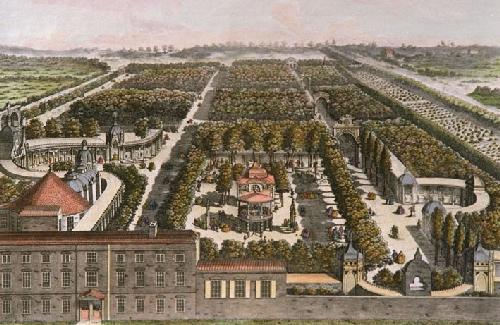Samuel Wale on:
[Wikipedia]
[Google]
[Amazon]
Samuel Wale (1721? – 1786) was an English historical painter and book illustrator.

 He became one of the original members of the
He became one of the original members of the

Life
He is said to have been born at Great Yarmouth,Norfolk
Norfolk () is a ceremonial and non-metropolitan county in East Anglia in England. It borders Lincolnshire to the north-west, Cambridgeshire to the west and south-west, and Suffolk to the south. Its northern and eastern boundaries are the No ...
, possibly on 25 April 1721, to Samuel and Margaret Wale, though some sources indicate he was born in London. He was first trained in the art of engraving on silver plate
Plating is a surface covering in which a metal is deposited on a conductive surface. Plating has been done for hundreds of years; it is also critical for modern technology. Plating is used to decorate objects, for corrosion inhibition, to impro ...
. He then studied drawing under Francis Hayman
Francis Hayman (1708 – 2 February 1776) was an English painter and illustrator who became one of the founding members of the Royal Academy in 1768, and later its first librarian.
Life and works
Born in Exeter, Devon, Hayman begun his arti ...
at the St. Martin's Lane academy
The St Martin's Lane Academy, a precursor of the Royal Academy, was organised in 1735 by William Hogarth, from the circle of artists and designers who gathered at Slaughter's Coffee House at the upper end of St Martin's Lane, London. The artistic ...
. Wale assisted John Gwynn in his architectural drawings, especially in a transverse section of St Paul's Cathedral, which was engraved and published in their joint names in 1752.
 He became one of the original members of the
He became one of the original members of the Society of Artists of Great Britain
The Society of Artists of Great Britain was founded in London in May 1761 by an association of artists in order to provide a venue for the public exhibition of recent work by living artists, such as was having success in the long-established P ...
in 1765 and of the Royal Academy in 1768, and was the first professor of perspective to the Academy. He exhibited drawings of scenes from English history, and occasionally scriptural subjects, described as designs for altar-pieces, from 1769 to 1778, when he suffered from a paralytic stroke, and he was placed on the Royal Academy pension fund, the first member who benefited by it. He continued to hold the professorship of perspective, though he gave private instruction at his own house instead of lecturing; and in 1782, on the death of Richard Wilson, he became librarian. He held both offices until his death on 6 February 1786. Unmarried and childless, he left his copperplates, prints, and belongings to his friend and fellow founder of the Royal Academy, architect John Gwynn, with whom he shared his house, and his nurse, Mrs. Mary Gurpin. He was buried in St. Martin-in-the-Fields. His portrait appears in Johann Zoffany's picture of the Royal Academy in 1772, engraved by Richard Earlom.
Works
He painted some decorative designs for ceilings at a time when the taste for that style of ornamentation was on the wane, and he was occasionally employed in painting tradesmen's signs, till these were prohibited by act of parliament in 1762. A full-length portrait of Shakespeare by Wale, which hung across the street outside a tavern near Drury Lane, obtained some notoriety owing to the splendour of the frame and the ironwork by which it was suspended. It had scarcely been erected when it had to be removed. His main work was in designing vignettes and illustrations on a small scale for the booksellers; a large number these were engraved byCharles Grignion the Elder
Charles Grignion the Elder (1721–1810) was a British engraver and draughtsman.
Grignion was born in London to Huguenot refugees. He was a prolific historical engraver and book illustrator.
He studied in London at Hubert-François Gravelot's sc ...
. Among them were the illustrations to the ‘History of England,’ 1746–7; ‘The Compleat Angler,’ 1759; ‘London and its Environs described,’ 1761; ‘Ethic Tales and Fables,’ William Wilkie
William Wilkie (5 October 1721 – 10 October 1772) was a Scottish Church of Scotland minister and Professor of Natural Philosophy primarily remembered as a poet nicknamed Potato Willie, known more respectfully as the "Scottish Homer". The son ...
's ‘Fables,’ 1768 (eighteen plates); Henry Chamberlain's ‘History of London,’ 1770; and Oliver Goldsmith's ‘Traveller,’ 1774. His book illustrations show Hayman's influence.
He also published numerous plates in the '' Oxford Magazine'' and other periodicals. He exhibited ‘stained drawings,’ i.e. designs outlined with the pen and washed with indian ink, and occasionally larger drawings in watercolours, at the exhibitions of the Society of Artists in Spring Gardens, 1760–1767, and designed the frontispiece to the catalogue in 1762.
References
* ;AttributionExternal links
* {{DEFAULTSORT:Wale, Samuel 1786 deaths 18th-century English painters English male painters British draughtsmen English engravers English illustrators Royal Academicians Year of birth uncertain People from Great Yarmouth 18th-century English male artists